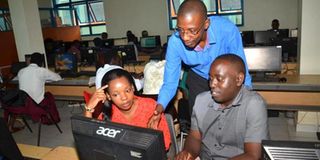Integrating students’ online lifestyles with academics

Students navigate a newly upgraded e- library. File photo
What you need to know:
Digital learning. Digital technology has been tipped to define everything associated with teaching and learning, writes RACHEAL IRENE NALUBEGA
The textbook is slowly fading out as the world shifts towards digital learning software and services.
Today, students across the board do not have to wholly sit in the library to carry out research, with most glued to their trendy gadgets such as smartphones, tablets or laptops.
An ‘Educause Review’ report published in June titled ‘Six Trajectories for Digital Technology in Higher Education’ cites some factors that have led to adoption of technology at a faster pace in institutions of higher learning. One of the top reasons being increased availability of mobile gadgets.
This trend has forced many institutions of higher learning to shift their approach towards education by integrating the students’ online lifestyles with the academic work.
“Higher education is mostly about research, and unlike in the past when use of online resources was an option, today it is a requirement,” says Ambrose Arinaitwe, the Information Technology manager at Cavendish University Uganda.
Mr Arinaitwe oversees management of all the institution’s technology facilities which include four high-end IT labs, internet access points and e-resource centers tailored to meet different learners’ needs.
The labs include a main research lab for all students, a practical lab for those students learning specialised skills like software development and hardware repair and maintenance and a Cisco lab. In addition there is a separate Law lab specifically equipped with law e-resources for law students.
Also, the university already has an e-resource centre that students can access anywhere and is also in the process of bar-coding all its textbooks to manage better access for students.
Even though the ratio of PC to students in institutions of higher learning is at around 1:7, over 70 per cent of the students have laptops. Nearly 100 per cent have smartphones.
Digital equipment
In the past, there was much discussion of the digital divide, where some students were able to afford digital equipment whereas others could not. Although the problem has not been fully resolved, the picture has shifted with the availability of lower cost devices.
“Such access to mobile devices enables the institution and students to access their e-books/recourses, hold discussion groups anywhere, do their research and assignments without necessarily going to the library,” Mr Arinaitwe says.
There has also been increased adoption of hybrid learning models by universities that simply cannot do without technology.
Ms Maria Mutebi, a third year Statistical Tools and Analysis student, says all that her course entails in on a PSS4 software.
“This is what we use throughout the course. It does not require internet, but it is also in some of the lab PCs for those without laptops,” Ms Mutebi says.
In the same way, the classwork has also become more practical, class activities include coming up with innovations and new development.
According to Mr Sam Kusasira, a Master in IT student, the ever-increasing amounts of data have also enabled the universities to transform in to a digital environment.
Mr Kusasira says the speeds have greatly improved and he is able to do his current research with no interruptions, compared to the speeds in the previous years while he was pursuing his undergraduate.
“It is no longer as expensive to provide data as it was before. For example, we provide students with 10 Mbps in our labs and the same is dedicated to our access points. This means students can be able to upload even the e-files at a high speed,” the IT manager adds.
Clearly, digital technology is increasingly defining everything associated with teaching and learning.
With more bandwidth available, more affordable gadgets in the hands of students and more resources going online there is no reason for higher education learning to remain fixed in the lecture halls.
It is up to the local institutions to lead Uganda towards this global direction in order to produce globally competitive graduates.
Going digital
Uganda is host to one of the largest implementations of eLearning in Africa to date. From urban uptown schools to village schools. In 2005, the Ministry of Education and Sports agreed to a pilot in 10 government secondary schools, deploying computerised Science and Mathematics software and virtual laboratory software. Having reached 250 schools, the ministry then joined hands with the Uganda Communications Commission (UCC), and the software by now has been installed in 750+ secondary schools – all over Uganda..
Also institutions of higher learning have not been left behind, with Cavendish University, Virtual University in Uganda, Makerene University, Kampala International University and IUIU among others embracing digital learning.




